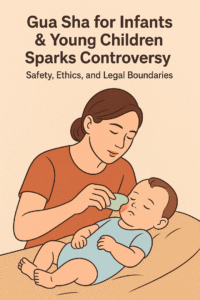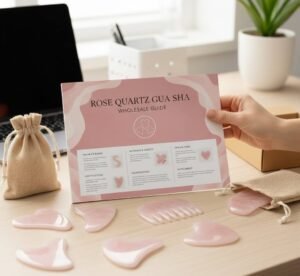
In recent years, with the growing popularity of natural therapies and the ubiquity of social media, Gua Sha has become a popular beauty and wellness treatment. This phenomenon is not limited to China; acceptance and understanding of Gua Sha are also growing abroad. It seems to have become a simple tool that can be used at will. However, a recent incident in China involving Gua Sha for infant has reignited public concern and controversy, sparking widespread social discussion about the safety, legality, and cultural boundaries of Gua Sha.
- What is Gua Sha?
- Event Review: Social Controversy Caused by Gua Sha for Infant
- Medical and Safety Hazards
- The Ethics and Legal Boundaries of Gua Sha for Infant
- Cultural Perspective: The Collision of Gua Sha Tradition and Modernity
- Implications for International Readers
- Infant Gua Sha FAQS
What is Gua Sha?
Gua Sha is a traditional Chinese medicine treatment. A smooth guasha board made of jade, ox horn, or metal is repeatedly rubbed against the skin to promote blood circulation, thereby relieving pain and fatigue. Among adults, Gua Sha is commonly used to relieve colds, stiff necks, and headaches. In recent years, guasha has also become widely used in facial beauty treatments. Using Gua Sha morning and night can eliminate or reduce facial swelling and dark circles.
However, there are fundamental differences between Gua Sha for infant and adults . These differences stem from differences in the body structure of infants and adults, such as muscle mass and skin thickness. Therefore, guasha techniques suitable for adults may not necessarily be suitable for infants and children.
Event Review: Social Controversy Caused by Gua Sha for Infant
In April 2025, a massage parlor in Chengdu, China, performed a gua sha massage on the neck of a six-month-old baby. The release of the video and photos sparked widespread public debate, primarily regarding the safety of gua sha for infant. Both sides of the debate held their own opinions, each seemingly offering a valid explanation.
Those in favor argued that guasha, with its thousands of years of historical experience, has proven its safety and efficacy. gua sha on children can help dispel cold and dampness, benefiting their health.
Opponents, on the other hand, argued that infants’ skin is too delicate, and that adult gua sha techniques could cause serious harm. Furthermore, infants cannot express themselves verbally, leaving the operator to determine the appropriate level of gua sha, which carries significant risks.
After the incident, relevant government departments launched an investigation, and the public began to reflect on whether this was a legitimate traditional care practice or a dangerous, overreaching practice?
Medical and Safety Hazards
Although Gua Sha is generally considered a safe treatment method, it is indeed a high-risk practice for infants and young children. From a medical perspective, the risks are significant:
- Skin and muscle damage: Infants and young children’s skin is extremely delicate and thin. Using guasha on infants and young children can easily cause bleeding, redness, and swelling of the skin and underlying muscles. If not handled properly, it can even lead to serious infections.
- Weakened immunity: Infants and young children’s immune systems are not yet fully developed. Skin damage from Gua Sha can lead to serious complications, even life-threatening conditions, due to a weakened immune system.
- Lack of scientific evidence and clinical data: Currently, no authoritative clinical studies have proven the clear efficacy of Gua Sha for infant and young children.
Many pediatric experts have expressed their opinions on this matter, but most agree that Gua Sha is not suitable for infants. Gentle manipulation and massage are more suitable for infants and young children.
The Ethics and Legal Boundaries of Gua Sha for Infant
Beyond medical discussions and safety debates, gua sha for infant has also sparked public scrutiny regarding ethical and legal considerations.
- In the Chinese context: The boundary between health services and medical practices is blurred, leading some institutions to conduct medically risky procedures under the guise of “health care.” Furthermore, due to the long-standing prevalence of Traditional Chinese Medicine (TCM), this practice is generally accepted in China, making it difficult to completely eradicate.
- International comparison: In most Western countries, medical procedures involving children must be performed by licensed physicians; unauthorized procedures may be considered medical malpractice or child injury.
- Ethical dilemma:
- Chinese parents hope to protect their children’s health through natural therapies while minimizing potential side effects from medications.
- However, infants lack the right to express themselves, and the safety of gua sha therapy relies entirely on the protection of their guardians and society. Once problems arise, it’s often too late to reverse course
This means that in cross-cultural health practices, we must not only respect traditions but also uphold the bottom line of “children’s safety cannot be crossed”.
Cultural Perspective: The Collision of Gua Sha Tradition and Modernity
In China, a significant number of parents still believe that gua sha therapy can cure their children’s ailments. This is understandable and closely tied to the millennia-old concepts of Traditional Chinese Medicine. While gua sha therapy certainly has miraculous effects in treating some conditions, it’s not suitable for everyone, at least not for all ages. For some, guasha therapy isn’t just a treatment method but a hidden belief—an overly ingrained obsession with Traditional Chinese Medicine.
Of course, with the advancement of modernization, the potential risks of guasha therapy have been increasingly exposed under the scrutiny of modern medicine, leading to an inevitable cultural clash: adhering to tradition or embracing modernity and continuous innovation.
For international readers, this phenomenon may be familiar. Similar controversies exist in Western society. Alternative medicine, such as cupping, herbal remedies, and spinal manipulation, are often questioned for their lack of scientific validation, yet continue to enjoy reliance in some communities.
Implications for International Readers
As Gua Sha becomes increasingly popular worldwide, more and more people are discovering it for beauty and wellness purposes. However, it’s important to clarify:
- Gua Sha is relatively safe for adults to use for beauty or relaxation.
- Gua Sha is extremely risky for infants and young children and should not be used.
For parents overseas, if their children experience health issues, they should immediately consult a professional pediatrician rather than relying on traditional or unproven alternative therapies. Overseas health and wellness centers and beauty brands should also clearly define boundaries, avoid marketing guasha as a panacea, and comply with the medical regulations of their respective countries.
The incident involving Gua Sha for infant and young children in Chengdu, China, serves as a reminder that the spread of traditional therapies in modern society must face the dual challenges of scientific validation and legal regulation. guasha, as both a form of adult culture and a beauty and wellness practice, can continue to be promoted and appreciated. However, when using it, we must be mindful of its potential risks, especially for vulnerable groups like infants and young children.
How to respect culture while protecting children’s health is a question that all societies must address when considering traditional therapies. In the future, only through scientific research, appropriate regulation, and international exchange can traditional medicine truly reach a broader global audience.
Infant Gua Sha FAQS
1. Is Gua Sha Recommended for Infants and Young Children?
Generally speaking, it is not recommended. Because infants and young children are not fully developed, they are more prone to adverse reactions to gua sha, and their symptoms are more severe. Furthermore, their recovery after gua sha is not as good as that of adults. Therefore, considering all the risks, gua sha is not suitable for infants and young children.
2. So, Is It Absolutely Forbidden to Perform Gua Sha on Infants and Young Children?
It is not absolutely prohibited. Gua sha (scraping therapy) can be performed on infants and young children under the evaluation and guidance of professionals. However, it is absolutely forbidden for private individuals to perform it, as this could cause irreversible harm.






